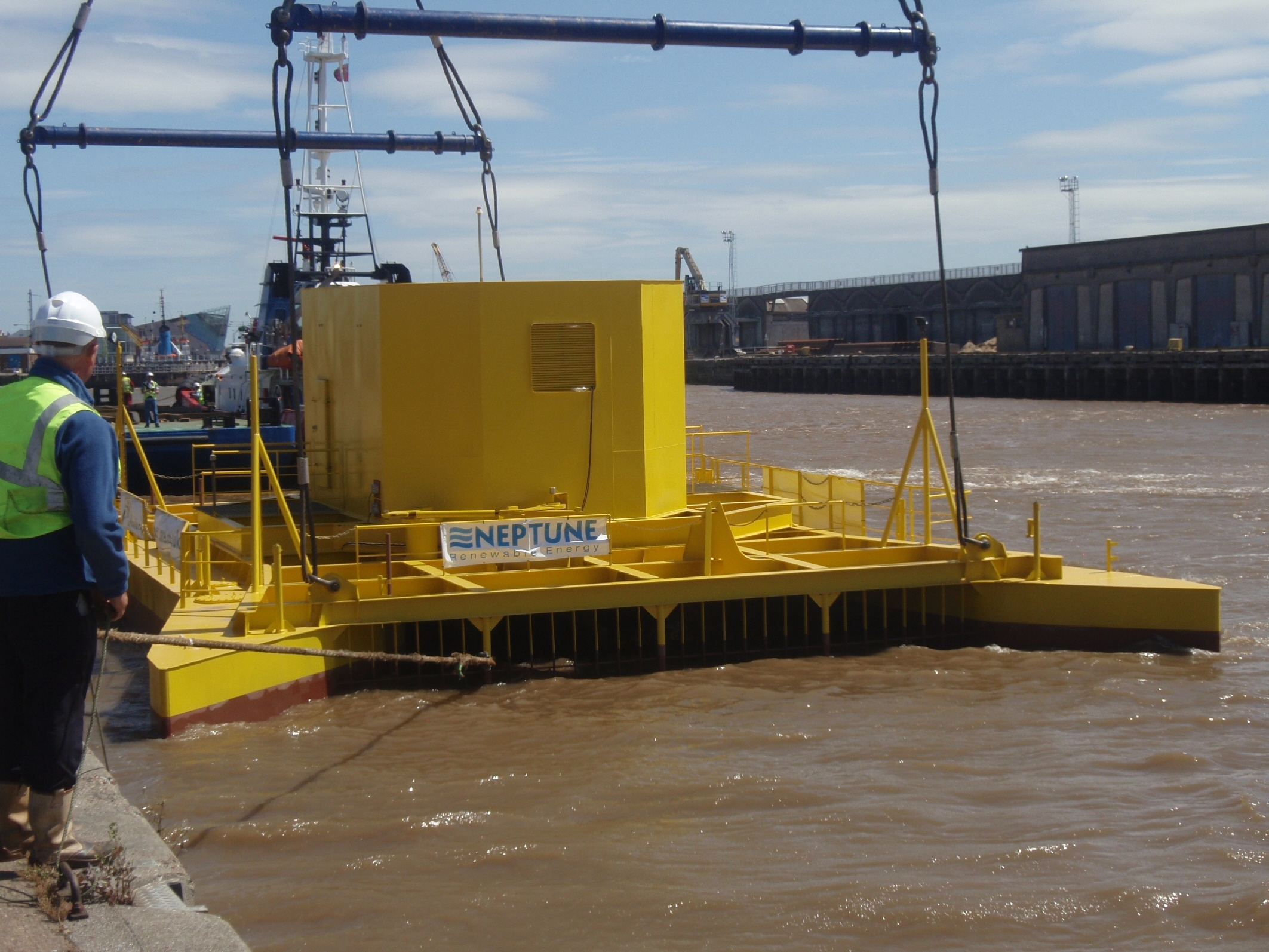The Proteus Demonstrator reached the William Wright Dock Hull at the weekend.
Neptune Renewable Energy Ltd (NREL) – based in North Ferriby, East Yorkshire – announces that the first full-scale demonstrator of its world-leading ‘green-energy’ Proteus tidal stream power plant, which can work equally well in ebb and flow currents, has now been transferred from Wear Dock in Sunderland and is safely moored in William Wright Dock in Hull whilst fitting out for deployment in the Humber. Weighing more than 150 tonnes and stretching to 20 metres long, with a beam of 14 metres, the Proteus NP1000 consists of a steel hull, vertically mounted turbine, and buoyancy chambers.
The delicate operation to move the Proteus demonstrator by crane from its position on the dockside in Sunderland, to a specially constructed frame on a waiting barge, was completed successfully on Wednesday 30th June. This was followed by the barge being towed by tug, with the Proteus safely secured, through the Sunderland Harbour lock gates, to the open sea which required careful coordination given that there was only a metre of clearance on each side. The Proteus Demonstrator reached the William Wright Dock Hull at the weekend, and was lowered into the water, to start a period of final commissioning before it embarks on an intensive three months of trials. When in place it is anticipated that the Neptune Proteus NP1000 will be able to generate at least 1000 MWh/year. To put this into context this would be enough to power 1000 homes.
Said Nigel Petrie, Chairman, Neptune Renewable Energy Ltd (NREL): “We are extremely pleased that the Proteus Demonstrator is now very much a reality. Its deployment is the culmination of five years of intensive efforts by Neptune and our partners and is a real first for the region, as we will be the only company to have a full-scale tidal stream power plant up and running in the Humber.
Although we had hoped, initially, to have commissioned the Proteus at the start of the year, the additional time spent on preparing the unit should pay dividends when it comes to the three months of trials which lie ahead.
“At Neptune we view tidal streams as a largely untapped resource where there is a tremendous opportunity for future growth using the latest technology like the Proteus. A major advantage of tidal stream power is the delivery of a predictable source of renewable energy compared to more variable, less consistent, options such as wind – something which is a key consideration when it comes to building-up generating capacity.”
“The key advantages which we believe set the vertical-axis Proteus apart from alternative solutions includes the fact that, at this stage, we are not aware of any similar device which is designed to capture the shallow water resource in estuarine sites at significantly lower capital and O&M (Operation and Maintenance costs). Certainly, a major innovation is the cross sectional shape that has been adopted for our patented design. The Proteus’ square turbine cross-section generates 30% more electricity per unit channel width compared to circular turbines. Additionally, the flow control shutters found in the Proteus increase the impacted length of the flow on the turbine providing greater shaft torque and power outputs.”
Neptune Renewable Energy Ltd (NREL) sees a number of practical benefits from focusing its efforts on estuarine locations such as the Humber, specifically:
the proximity of the generating capacity to the grid or distribution supply points; the absence of wave activity on the structure as it can be moored in sheltered areas; and being close to land simplifies installation and maintenance. When it comes to operation and maintenance, all Proteus turbine components have been designed to be serviceable on site except for the lower bearing which can be serviced and replaced with local dry-docking. Crucially, the device can be towed to site using a small tug. Additionally, as a moored system, its environmental footprint is low – making it an attractive option in particularly sensitive locations.
The Humber Estuary was specifically chosen by Neptune for the first deployment of the Proteus as its depth and tidal flow is considered one of the best locations in the British Isles for tidal stream power whilst it is also relatively close to the company’s base in North Ferriby. The Company’s location has also enabled the design to be refined and naval architects IMT/OSD Marine, engineers Water Hydraulics, Ormston Technology in Beverley and Dane Electrical Engineering in Filey, all playing key roles to make the project a reality.
Throughout the process, at a municipal level, Hull City Council has been extremely supportive of Neptune’s efforts, appreciating the economic and practical benefits of Proteus and have already agreed that the output from the demonstrator will help to power The Deep Submarium in Hull. Upon the completion of the demonstrator trials, Neptune’s aim is to have the world’s first tidal stream power array, consisting of advanced Proteus designs, up and running close to The Deep in the Humber during 2011-12.
For more information on Neptune Renewable Energy Ltd (NREL) please visit:
www.neptunerenewableenergy.com. For Wear Dock and Engineering please log on to www.weardock.co.uk.
“At Neptune we view tidal streams as a largely untapped resource where there is a tremendous opportunity for future growth using the latest technology like the Proteus. A major advantage of tidal stream power is the delivery of a predictable source of renewable energy compared to more variable, less consistent, options such as wind – something which is a key consideration when it comes to building-up generating capacity.”








